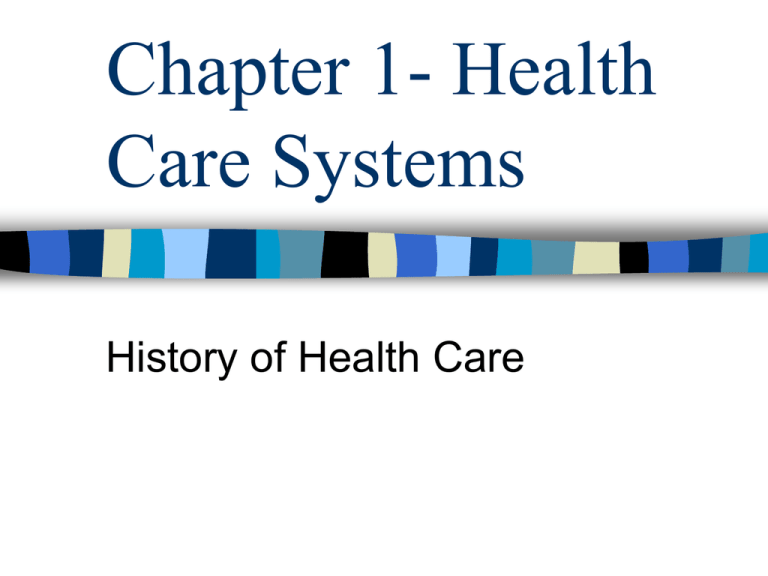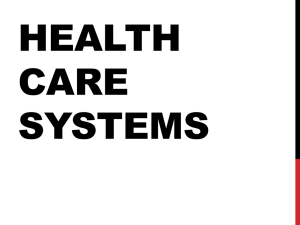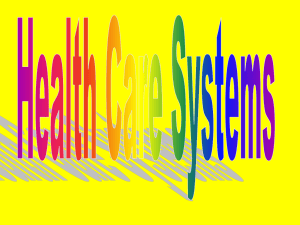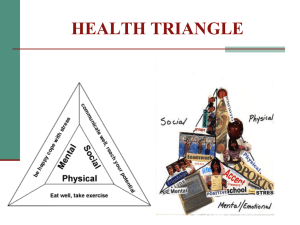Chapter 1- Health Care Systems - Kings County Office of Education
advertisement

Chapter 1- Health Care Systems History of Health Care Pertinent questions When did most of the most significant changes in health care occur? Why were the greatest advances made in this time period? What are some possibilities for the future of health care? Health Care Systems 1. 2. 3. 4. Many different types deliver health care Largest & fastest growing industry Employs over 10 million workers in over 200 careers $2,000,000,000 per day industry Hospitals – vary in size & type of services General hospitals – varied services Specialty hospitals – certain conditions or ages (burns, pediatrics, cancer, heart, etc) Government hospitals – fed, state, local (VA, military, state rehab or psychiatric) University or college medical centers – provide services, RESEARCH, education Classification – based on funding sources Private or proprietary – for profit (pt. fees & organizational support) Religious – religious support, pt. fees Non-profit or voluntary – pt. fees, donations Government – taxes, pt. fees Long Term Care Facilities (LTC) Provide care for elderly, physical or mental disabilities, chronic or long term illnesses Pts are usually called residents Nursing homes or geriatric homes – provide ADLs for those unable to care for themselves, provide a safe environment, & promote social interactions Extended Care or Skilled Care Facilities Provide skilled nursing & rehab care Prepare resident for return to home environment Subacute units – rehab for surgery, cancer tx, dialysis Independent or assisted living facilities – individuals receive the help they need (meals, transportation, housekeeping, etc) Many are associated with LTC facilities, enabling the individual to move from facility to facility as need arises Medical Offices Privately owned offices to large corporations Services: diagnosis, treatment, examinations, basic lab tests, minor surgery Some treat wide variety of illness/ages & others specialize Dental Offices Private offices to dental clinics Can be found in major retail stores Can provide general or specialized dental care Clinics Can refer to a group of medical/dental professionals who share a facility & staff Others specialized – surgery, emergency care clinics, rehab clinics, diabetes or oncology clinics Can be affiliated with a hospital Health department – pediatrics, sexually transmitted diseases, immunizations, other special services Medical centers at universities – frequently free or reduced cost care to provide learning Optical Centers May be individually owned or part of a large chain Provide vision examinations, prescribe eyeglasses or contacts, check for eye diseases Emergency Care Services Provide special care for accidents or sudden illness Examples – ambulance, rescue squads, emergency care clinics, emergency rooms in hospitals, helicopter or airplane Laboratories Can be part of another facility or separate health care service Medical labs – perform diagnostic tests Dental labs – prepare dentures and other devices Home Health Care Provides care in patient’s home Examples – nursing, personal cares, therapy, homemaking Offered by health departments, hospitals, private agencies, government agencies, nonprofit agencies, volunteer groups Hospice Provides care for terminally ill persons with a life expectancy of 6 months or less Care provided in home or hospice facility Allows death with dignity & comfort Provides psychological, social, spiritual, & financial counseling for pt. & family Mental Health Facilities Deal with mental diseases and disorders Examples – guidance/counseling centers, psychiatric clinics/hospitals, chemical abuse treatment centers for alcohol or drug abuse, physical abuse treatment centers Genetic Counseling Centers Can be independent or affiliated Works with couples or individuals who are pregnant or considering pregnancy Performs prenatal screening, check for genetic abnormalities & birth defects, explains test results, identify medical options when defect is present, help individuals cope with psychological issues caused by genetic disorder Used especially for older women, family history of genetic disease, specific race/nationality where genetic disease is Rehabilitation Facilities Care directed at helping pt. with mental or physical disability obtain maximum function Includes hospitals, clinics, private centers Services – physical, occupational, recreational, speech, & hearing tx Health Maintenance Organizations Provide total health care directed toward preventive care Services: examinations, basic medical services, health education, hospitalization, rehabilitation Mode of operation – large industry/corp, private agencies, uses services of other health care facilities Industrial Health Care Centers or Occupational Health Clinics Located in large industries or companies Provides health care for employees Services – basic exams, teach accident prevention/safety, provide emergency care School Health Services Found in schools & colleges Services – emergency care for accidents & sudden illnesses, speech/vision/hearing screenings, promote health education, maintain safe & sanitary school environment, counseling Government Agencies Offered at international, federal, state, local levels – most tax supported World Health Organization (WHO) – international agency supported by United Nations that provides statistics & information about disease, publishes health information, & investigates & deals with serious health problems throughout the world United States Department of Health & Human Services (USDHHS) National Institute of Health (NIH) – researching disease Centers for Disease Control & Prevention (CDC) – researches causes, spread, & control of diseases in populations Food & Drug Administration (FDA) – regulates food & drug products sold to the public USDHHS (cont) Agency for Health Care Policy & Research (AHCPR) – established in 1990 to research quality of health care delivery & identify standards of treatment Occupational Safety & Health Administration (OSHA) – establishes & enforces standards protecting workers from job-related injuries & illnesses State & Local Health Departments Provides health services as directed by USDHHS Provides specific needed services – immunizations, inspections for environmental health & sanitation, communicable disease control, collection of statistics & health records, health education, clinics for health care & prevention Volunteer or Nonprofit Agencies Supported by donations, membership fees, fundraisers, & grants Provides health services at national, state, or local levels Examples – American Cancer Society, American Heart Association, American Diabetes Association, American Red Cross, March of Dimes, etc. Many deal with one disease or group of diseases to study, provide funding for research, promote education, purchase medical equipment, provide treatment centers, & supply information Health Insurance Plans Cost of health care a major concern Cost of health care is >12% of gross national product Health care costs are increasing faster than other costs of living Most people rely on health insurance plans to pay for health care costs Without insurance, cost of illness disastrous Health Insurance Plans Different plans offered by thousands of agencies Pay a premium to purchase insurance If insured person has expenses covered by the plan, the insurance company pays for them Amount of payment and services vary from plan to plan Insurance terminology Deductibles – amounts that must be paid by the insured individual before policy begins to pay Co-insurance – requires specific percentage of expenses to be shared by individual & company (80-20 80% paid by company, 20% paid by individual) Co-payment – specific amount of money patient pays for a particular service (example - $20 per doctor’s appointment regardless of total cost) Insurance Plans Many people have insurance from place of employment Private policies can be purchased by individuals Health Maintenance Organizations Special type of insurance plan Monthly fee is paid for membership & price remains same, regardless of number of visits Premium paid either by employer or individual Most pay for total health care – routine visits & exams & preventive health care (not usually covered by private insurance) Health Maintenance Organizations Advantages – provides ready access to health care, early detection & treatment of disease, individual usually maintains better health Disadvantages – individual can only use HMO affiliated providers for health care. If choose a provider outside of HMO, individual pays for all costs Preferred Provider Organizations (PPO) Usually provided by large company Company contracts with health care agency Employee must use specific health care agency Industry/company can provide health care at lower rates Medicare Federal government health care plan Provides health care to those over 65 years of age or persons with a disability who have had social security benefits for at least 2 years Type A coverage – hospital services & LTC facility after hospitalization Type B coverage – Dr. services, outpatient therapy, other health care. Individual pays premium for this coverage. 80-20 coinsurance – Medicare pays 80%, individual or insurance pays 20% Medicaid (MediCal) Medical assistance program offered by states (vary from state to state) Covers individuals with low incomes, children who qualify for public assistance, the physically disabled or blind State Children’s Health Insurance Program (SCHIP) – established 1997 to provide health care to uninsured children of working families who earn too much to qualify for Medicaid Worker’s Compensation Provides treatment for workers injured on the job Administered by the state Payments made by employers & state Provides payment for health care & lost wages United States Government Plans Provides health care for all military personnel TRICARE Cares for all active duty members & families Cares for survivors of military personnel & retirees & their families Veteran’s Administration provides for military veterans with service connected disability Managed Care Developed because of rising health care costs & need to spend money efficiently All health care must have a purpose Second opinion or verification of need often required Includes preventive care, physical exams, well-baby care, immunizations, wellness education (good nutrition, exercise, weight control, healthy living) Usually provided by HMOs & PPOs by setting up network of providers – restricted usage Organizational Structure Often called line of authority or chain of command Indicates area of responsibility Leads to efficient operation of facility Hospital Organizational Chart Shows organization by departments Notes various divisions of departments Each department can have an individual organization Medical Office Organizational Chart Simpler organizational chart Even with fewer people, lines of authority are clearly shown & easy to follow Summary In both cases, chain of command is clearly indicated Health care workers must identify & understand their position in the organizational structure Allows workers to know the line of authority & understand who is their immediate supervisor Questions/concerns/problems – go to immediate supervisor If supervisor is unable to solve the problem, go to the next level in the chain. Trends in Health Care Many events lead to changes in health care (example AIDS) Changes occur almost daily 1st trend is cost containment Methods Used to Contain Costs Diagnostic related groups – DRGs – Attempt by Congress to control costs – Payment based on diagnosis – Certain amount paid for each disease/condition – Agencies that provide care for less keep the money – Agencies accept loss if care costs exceed payment allowed Combination of Services Agencies combine services to avoid duplication Share clinics, labs, etc HMO & PPO examples Provides care to larger number of people at a decrease in cost per person Outpatient Services Patients receive care without being admitted to hospitals Reducing length of stay or decreasing need for hospitalization lowers costs Often use less expensive home care or skilled nursing care Examples – outpatient surgery, xrays, diagnostic tests Mass or Bulk Purchasing Buying equipment & supplies in larger quantities at reduced prices Often combines department or agency orders Computerized inventories can be used to determine when supplies are needed & to prevent overstocking & waste Early Intervention & Preventive Services Providing care before acute or chronic disease occurs Prevention is ALWAYS more cost effective Methods – immunization, patient education, regular physical exams, easy access to health care, incentives for prevention Studies show people with limited access to health care use emergency departments Energy Conservation Monitoring use of energy to control costs & conserve resources Electricity, water, gas Energy efficient buildings Recycling Agency for Health Care Policy & Research (AHCPR) Federal agency developed in 1990 Purpose – to research quality of health care delivery & identify standards of treatment that should be provided Quality of health care should not be lowered simply to contain costs Need to provide quality care while be attentive to avoiding waste & controlling costs Consumers need to be responsible as well Home Health Care Rapidly growing field due to insurance regulating hospital stays Less expensive to perform All aspects involved – nursing, physical & occupational therapy, respiratory therapy, social services, nutritional services, homemaking services What are advantages to home care? Geriatric Care Care of the elderly Rapid growth due to longer life spans & “baby boomers” Lead to growth of facilities – adult day care, retirement communities, assisted & independent living facilities, LTC facilities Geriatric Care Omnibus Budget Reconciliation Act (OBRA) of 1987 – Federal law creating regs regarding LTC and home health – Requires state to establish training & competency programs for assistants – Requires nursing assistants to: • Complete mandatory state-approved training • Pass written & competency exams • Obtain certificate or registration Geriatric Care Other OBRA requirements – Continuing education – Periodic performance evaluations – Retraining/retesting if CNA does not work in a facility for more than 2 years States must maintain registry Requires compliance with patients’ rights to ensure certain standards of care Telemedicine Uses video, audio, & computer systems to provide health care services Allows interaction even though workers are in different locations – EMTs at scene of accident – Surgeons using remote control arms – Watching procedures by video May allow people to receive tx in homes Wellness State of being in optimum health with balanced relationship between physical, mental, & social health Recognizes importance of – – – – Good nutrition Exercise Weight control Healthy living habits What are examples of facilities stressing this? 5 Ways to Promote Wellness Physical wellness – Well-balanced diet – Regular exercise – Routine physical exams/immunizations – Regular dental/vision care – Avoidance of alcohol, tobacco, caffeine, drugs, environmental contaminants, & risky sexual behaviors 5 Ways to Promote Wellness Emotional Wellness – Understanding feelings & expressing them appropriately – Accepting one’s limitations – Adjusting to change – Coping with stress – Enjoying life – Remaining optimistic 5 Ways to Promote Wellness Social Wellness – Showing concern, fairness, affection, tolerance, & respect for others – Communicating & interacting well – Sharing thoughts & ideas – Practicing honesty & loyalty 5 Ways to Promote Wellness Mental & Intellectual Wellness – Being creative, logical, curious, & openminded – Using common sense – Obtaining continual learning – Questions/evaluating information & situations – Learning from life experiences – Using flexibility & creativity to problem solve 5 Ways to Promote Wellness Spiritual Wellness – Using values, ethics & morals to find meaning, direction, & purpose in life Alternative & Complementary Methods of Health Care Most health care in the U.S. is biomedical or “Western” system – Based on evaluating physical signs & symptoms, determining cause of disease, & treatment Major trend towards other methods – Alternative therapy – in place of biomedical – Complementary – Used with biomedical Holistic Health Care Part of alternative/complementary tx Consider the whole person & recognizes that the health of each part has an effect on total health status Life force or energy helps with healing Many therapies based on culture Skilled practitioners, rituals, specialized practices part of therapy Examples of Alternative or Complementary Practitioners Ayurvedic practitioners – Indian philosophy to maintain harmony by diet, exercise, yoga, & living practices Chinese medicine – Life energy flows through the person through pathways that link the organs together: use acupressure & accupuncture, tai chi, herbs to maintain energy flow Examples continued Chiropractors – brain sends vital energy through nerves in spinal cord, misalignment causes pain: use spinal manipulation, massage, & exercise Homeopaths – body has ability to heal itself through the immune system: use drugs from plants, animals, & minerals to cause symptoms & activate immunity Examples cont. Hypnotists – help people achieve a trance-like state to become receptive to verbal suggestions to change behaviors Naturopaths – use only natural therapies like fasting, special diets, lifestyle changes & avoid surgery or medicine Alternative/Complementary Medicine Most therapies are holistic & noninvasive Most are less expensive than traditional treatments Office of Alternative Medicine (OAM) – established by NIH to research therapies & determine standards of quality care. Practioners may required education or licenses before practicing. Also labels therapy as experimental. Remember Patients have the right to choose their own type of care Be non-judgmental Important for health care providers to be aware of alternative treatments National Health Care Plan High costs of health care + large number of uninsured people = need for this plan No current plan, many have been proposed Problems – cost of creating, who pays more, lack of free choice, new regulations need to be created Past & Current Trends Polio vaccine Antibiotic development Cancer & AIDS drugs Computers Test tube babies Cloning Health care will continue to change – be aware!







